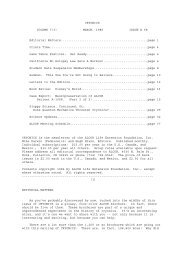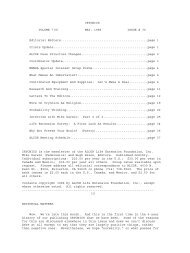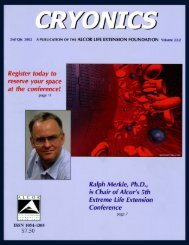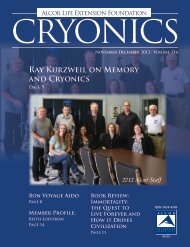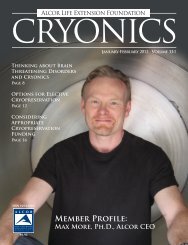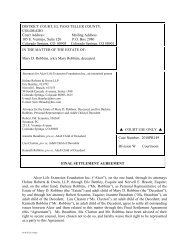CURTIS HENDERSON - Alcor Life Extension Foundation
CURTIS HENDERSON - Alcor Life Extension Foundation
CURTIS HENDERSON - Alcor Life Extension Foundation
- No tags were found...
You also want an ePaper? Increase the reach of your titles
YUMPU automatically turns print PDFs into web optimized ePapers that Google loves.
iological bypass in patients with chroniccoronary artery disease and ischemic cardiomyopathy,which results when arteries thatsupply blood and oxygen to the heart areblocked. The study is scheduled to appear inthis week’s online issue of the Proceedings of theNational Academy of Sciences.AJC.com8/17/09http://www.ajc.com/health/content/shared-auto/healthnews/cora/630096.html___________________________________Single Molecule’sStunning ImageThe detailed chemical structure of a singlemolecule has been imaged for the first time,say researchers. The physical shape of singlecarbon nanotubes has been outlined before,using similar techniques—but the newmethod even shows up chemical bonds.Understanding structure on this scale couldhelp in the design of many things on themolecular scale, particularly electronics oreven drugs. The IBM researchers report theirfindings in the journal Science. It is the samegroup that in July reported the feat of measuringthe charge on a single atom. In bothcases, a team from IBM Research Zurichused an atomic force microscope or AFM.Their version of the device acts like a tinytuning fork, with one of the prongs passingincredibly close to the sample and the otherfarther away. When the fork is set vibrating,the prong nearest the sample will experiencea minuscule shift in the frequency of itsvibration. Comparing the frequencies gives ameasure of just how close the nearer prongis, effectively mapping out the molecule’sstructure. Lead author of the research LeoGross told BBC News that the group isaiming to combine their ability to measureindividual charges with the new technique,characterizing molecules at a truly unprecedentedlevel of detail.Atomic force microscope (SPL).BBC News8/28/09http://news.bbc.co.uk/2/hi/science/nature/8225491.stm___________________________________How Broccoli Can ProtectYour ArteriesIt’s long been thought that broccoli is goodfor your heart, and now British scientiststhink they know why. Farm workers of theD’Arrigo Brothers Company harvest broccoliin Salinas Valley, often called the “SaladBowl of the World,” in the central coastregion of California. Researchers at ImperialCollege London have found evidence achemical in broccoli and other green leafyvegetables could boost a natural defensemechanism that protects arteries from theclogging that can cause heart attacks. In astudy funded by the British Heart<strong>Foundation</strong> charity and conducted on mice,the researchers found that sulforaphane—acompound occurring naturally in broccoliand other brassicas—could “switch on” aprotective protein which is inactive in partsof the arteries vulnerable to clogging. “Weknow that vegetables are clearly good foryou, but surprisingly the molecular mechanismsof why they are good for you haveremained unknown for many years,” saidPaul Evans of the National Heart and LungInstitute at Imperial College. “This studyprovides a possible explanation for howgreen vegetable consumption can promote ahealthy heart.”Reuters9/4/09http://www.reuters.com/article/scienceNews/idUSTRE5833ZZ20090904___________________________________Insulin Boost Restores MuscleGrowth in ElderlyRecently, scientists have recognized that lossof responsiveness to insulin plays a major rolein the loss of physical strength that occurs aspeople grow older. Now, University of TexasMedical Branch at Galveston researchers havedemonstrated that by increasing insulin levelsabove the normal range in elderly test subjects,they can restore the impaired musclebuildingprocess responsible for age-relatedphysical weakness. “Insulin is normallysecreted during food intake,” said Dr. ElenaVolpi, senior author of a paper on the studypublished in the September issue ofDiabetologia. “When you give insulin intravenouslyand increase the blood insulin levelsto the same amount produced after a meal,you see that in young people it stimulatesprotein synthesis and muscle growth, while inolder people it really doesn’t. But when wegave seniors double the insulin they wouldnormally produce after eating, their muscleswere stimulated like those of young people.”ScienceDaily9/27/09http://www.sciencedaily.com/releases/2009/09/090925115457.htm___________________________________A Genetic Fountain of YouthBy disabling a gene involved in an importantbiochemical signaling pathway, scientistshave discovered a way to mimic the wellknownanti-aging benefits of caloric restriction,allowing mice to live longer andhealthier lives. This finding, published onlineOct. 1 in Science, offers a promising drugtarget for combating the many health problemsassociated with aging. “This researchpoints the way to potential pharmacologicalapproaches to treating aging-related diseasesin humans,” says senior author DominicWithers, professor of diabetes andendocrinology at University College London.“It really defines this as a pathway that’saffecting aging all the way from yeast tomammals, which I think is pretty striking,”says Matt Kaeberlein, professor ofpathology at the University of Washingtonand coauthor of a commentary accompanyingthe new study. Caloric restriction haslong been known to extend lifespan andreduce the incidence of age-related diseasesin a wide variety of organisms. Exactly howa nutritionally complete but radicallyrestricted diet achieves these benefits hasremained unclear. But recently severalstudies have offered evidence that a particularsignaling pathway, involving a proteincalled target of rapamycin (TOR), may play apivotal role.Technology Review (MIT)10/1/09http://www.technologyreview.com/biomedicine/23560/___________________________________www.alcor.org Cryonics/Third Quarter 200921



